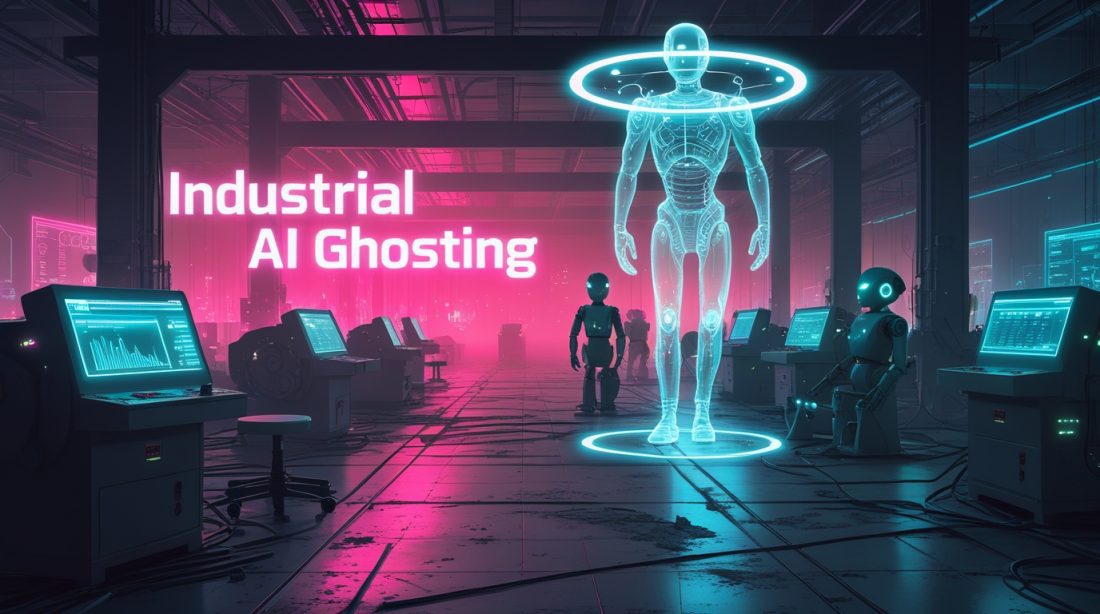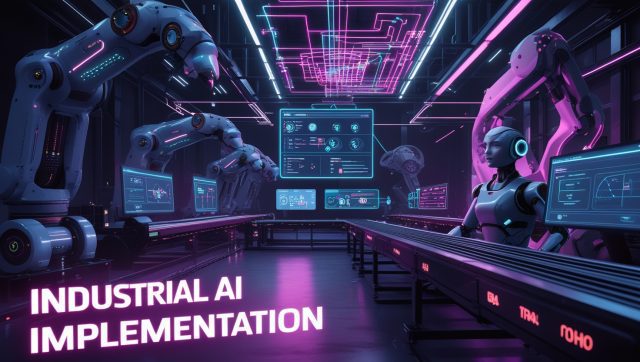The Hidden Multi-Million Dollar Problem: Industrial AI Ghosting in 2025
A startling trend is emerging in manufacturing: industrial AI ghosting. This is the phenomenon where companies invest significant resources into developing and deploying artificial intelligence models, only for them to be abandoned by the very workforce they were designed to help.
While headlines tout AI’s potential, the factory floor tells a different story. A 2025 Industrial AI Market Report reveals that the average US manufacturer spends a mere 0.1% of its revenue on AI. This underinvestment is a symptom of a deeper issue—a disconnect between technology and people. Despite most large manufacturers now having CEO-driven AI strategies, many projects fail to integrate with human workflows, leading to silent, unused models that represent millions in wasted investment.
This isn’t just a technical failure; it’s a human and financial one. Understanding why industrial AI projects fail is the first step toward solving it. The cost of unused AI in manufacturing is quietly stacking up across the sector.
Why Are Perfectly Good AI Models Being Ghosted?
The decision to abandon an AI system is rarely malicious. It’s typically the result of fundamental oversights in planning and execution. Here are the core reasons ghosting occurs.
1. The Critical Skills Gap and Lack of Training
The most cited barrier to AI adoption is a “Lack of internal expertise or knowledge,” with 45% of manufacturers pointing to this issue. When operators and line managers don’t understand how an AI vision system for defect detection works or how to interpret its alerts, they lose trust in it. They default to the manual methods they know, leaving the AI model to gather digital dust. In response, 60% of manufacturers are now actively investing in training and upskilling existing employees.
A Fictional Anecdote: Maria, a production line supervisor at an automotive parts plant, was told a new AI vision system would automate defect detection. After a two-hour training session, the system flagged a minor scratch she would have ignored. With no one to ask and a line to keep moving, she overrode the alert. Within a week, the entire team was bypassing the “overly sensitive” AI, reverting to their old, trusted manual checks.
2. The “Black Box” Problem and Lack of Trust
Many AI systems, particularly complex neural networks, operate as “black boxes.” They provide an output—a prediction, a detected defect—but no intuitive explanation for why. For a seasoned plant engineer with decades of experience, being told to act on a recommendation without understanding the underlying logic is frustrating and unconvincing. This lack of transparency and explainability erodes trust, making workers more likely to disregard the AI’s advice. Solving the black box problem in industrial AI is critical to building trust.
3. Clunky Integration with Existing Workflows
AI tools often require workers to log into a separate portal, navigate new software, or input data in unnatural ways. This creates friction. If using the AI slows an operator down, even by a minute per task, it will be rejected. As one report on AI workers noted, systems that treat humans like robots are doomed to fail; workers feel dehumanized and pushed to the sidelines. AI must integrate seamlessly into existing tools and processes to be adopted—especially with SCADA and MES systems.
4. The Data Quality and Architecture Dilemma
AI models are only as good as the data they are fed. Traditional industrial environments struggle with fragmented data systems—siloed SCADA networks, MES deployments, and data historians. If an AI model for predictive maintenance is fed incomplete or low-quality historical data, its predictions will be inaccurate. Workers quickly learn the system is unreliable and stop using it. This has spurred the rise of Industrial DataOps, the fastest-growing industrial software segment, to clean and contextualize data for AI consumption. Explore how small factories are struggling with data costs in AI Cloud Ingestion Fees: 5 Alarming Reasons
5. Misaligned KPIs and Missing ROI
A common scenario: corporate leadership invests in AI to optimize for overall equipment effectiveness (OEE), while frontline teams are rewarded for units produced per hour. If pausing a machine for an AI-recommended maintenance check hurts a team’s short-term production bonus, the recommendation will be ignored. When the benefits of using AI are not reflected in the KPIs for successful AI adoption, ghosting is the inevitable result.
6. Lack of Frontline Involvement in Development
AI tools built in isolation—without input from the people who will actually use them—often miss the mark. When operators aren’t consulted during design, the result is a system that feels imposed, not helpful. This lack of ownership leads to employee resistance to new AI technology. Co-development isn’t a luxury—it’s a necessity.
7. No Feedback Loop or Iteration
Once deployed, many AI systems are treated as “done.” But frontline users often encounter edge cases, bugs, or usability issues that need refinement. Without a clear feedback loop to improve the model based on real-world use, frustration builds and adoption drops. AI must evolve with the workflow—not just launch and vanish. This is where AI vendors play a critical role in preventing ghosting.
The Multi-Million Dollar Impact of Ghosting Your AI
The cost of industrial AI ghosting isn’t just the initial development budget. It’s the massive opportunity cost of unrealized gains.
- Direct Financial Loss: AI projects that are deployed but not used represent a pure sunk cost. France-based automotive manufacturer Renault SA reported €270 million in savings on energy and maintenance in a single year by successfully deploying AI tools. Ghosted systems represent the inverse—a loss of potential savings that directly impacts the bottom line. (See: case study Renault AI savings) Renault’s partnership with COMPREDICT to deploy predictive maintenance across 10 million vehicles by 2030 highlights the scale and ROI potential of industrial AI when properly adopted (source).
- Erosion of Future Investment: When AI initiatives consistently fail to deliver a return, executives become skeptical of funding new projects. This creates a vicious cycle where promising AI applications can’t get the budget they need because of the ghosts of projects past.
- De-skilling of the Workforce: Over-reliance on outdated manual processes, instead of augmented intelligence, prevents the workforce from developing the critical digital skills needed to stay competitive. This widens the very AI skills gap in manufacturing 2025 that caused the problem in the first place.
How to Prevent AI Ghosting: Building a Human-Centric AI Strategy
The solution to ghosting is to stop treating AI as just a technology project and start treating it as an organizational transformation.
- Co-Development and Change Management: Involve end-users—the operators, technicians, and engineers—from the earliest stages of AI development. Their frontline expertise is invaluable for creating a usable, trustworthy tool. Pair technical rollout with robust change management for AI implementation. See how stakeholder fear can derail retraining budgets in How Stakeholder Fear Kills AI Retraining Budgets Mid-Cycle
- Invest in Explainable AI (XAI) and Upskilling: Prioritize AI solutions that provide clear, interpretable reasons for their outputs. As one analysis of the industrial AI market noted, “explainability, safety, and payback discipline drive what gets deployed.” Simultaneously, follow the lead of companies like Toyota, which has launched a Software Academy with 100 training courses to strengthen AI and software skills among its workforce. Toyota’s launch of its Software Academy and Global AI Accelerator reflects a serious commitment to workforce transformation in AI and software development (source).
- Focus on Seamless Integration and User Experience (UX): Design AI interfaces that integrate directly into the workflow. The goal should be to minimize clicks and cognitive load, making the AI a natural assistant, not a separate task.
- Build a Scalable Data Foundation: Before deploying advanced models, invest in industrial DataOps and unified data architectures (like data lakehouses) to ensure a consistent flow of high-quality, contextualized data. See how latency issues are being solved in How to Fix IIoT Data Latency
- Align Metrics and Incentives: Ensure that the key performance indicators for frontline teams are aligned with the goals of the AI system. Reward adoption and the correct use of AI-driven insights.
Final Verdict
Industrial AI ghosting is a silent epidemic draining resources and stifling innovation in manufacturing. It reveals a simple truth: technology, no matter how advanced, is useless without human adoption. The path forward requires a fundamental shift from a pure tech-push to a human-centric AI strategy. By closing the skills gap, building transparent systems, and seamlessly integrating AI into the human workflow, manufacturers can stop the ghosting and start realizing the billions in value that AI truly promises. For a broader look at industrial AI market dynamics, check out AGIBOT Hong Kong IPO 2026
FAQ
What is industrial AI ghosting?
It occurs when a company develops and technically deploys an artificial intelligence model, but the intended users (e.g., operators, engineers) do not adopt it into their daily workflows, effectively abandoning the technology despite its potential.
What is the main cause of AI project failure in industry?
The primary cause is not the technology itself, but human and organizational factors. The top barrier is a “Lack of internal expertise or knowledge,” cited by 45% of manufacturers, highlighting that skills gaps and poor integration into human workflows are the core issues. A 2025 MIT report found that 95% of enterprise AI pilots fail to deliver ROI, often due to poor integration and lack of user adoption (source).
How big is the industrial AI market?
The global industrial AI market reached $43.6 billion in 2024 and is expected to grow at a rapid rate (23% CAGR) to $153.9 billion by 2030, making the effective adoption of these technologies critically important.
Fast Facts
Industrial AI ghosting is the multi-million-dollar problem of deployed AI models being abandoned by workers. It’s caused mainly by a lack of training, untrustworthy “black box” systems, poor integration into daily work, and misaligned incentives. The solution is a human-centric approach that prioritizes co-development, explainability, and upskilling over pure technology.
Stay Ahead of the Curve. The world of industrial AI moves fast. Get the latest insights, analysis, and case studies on AI implementation delivered directly to your inbox. Subscribe to our newsletter to ensure your projects succeed, and don’t become another ghost story.

